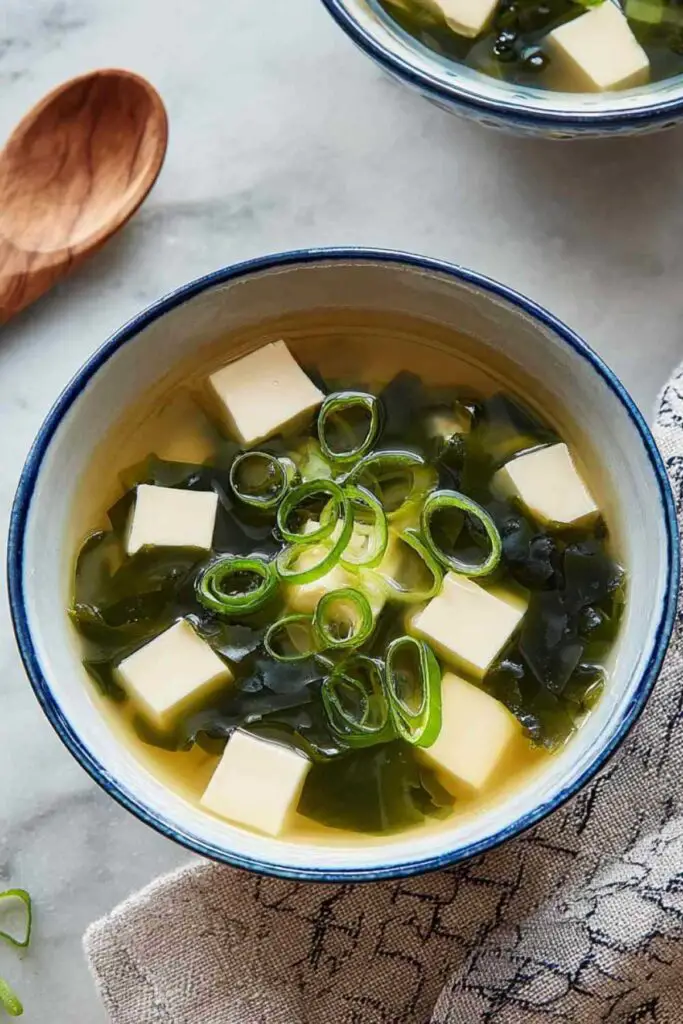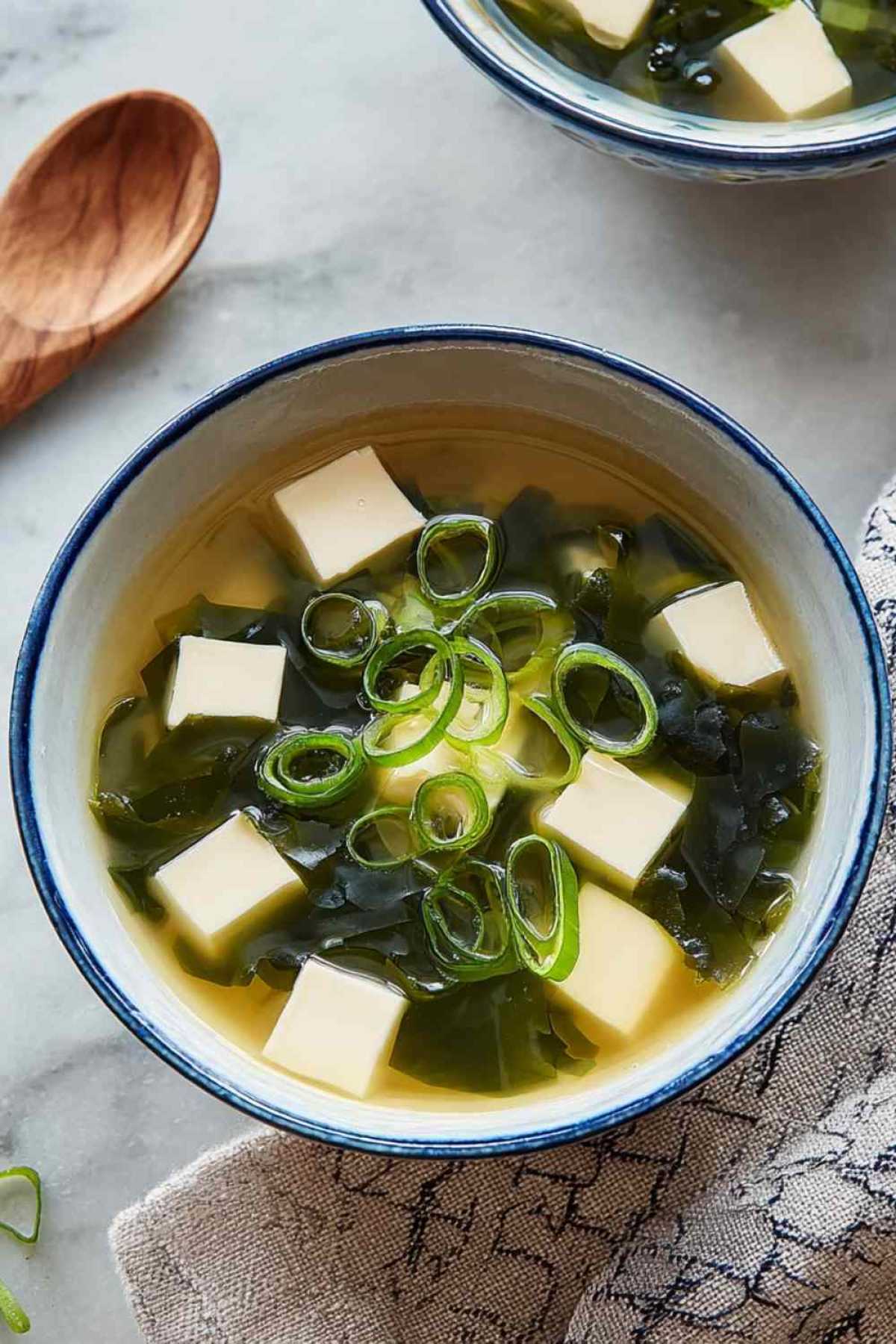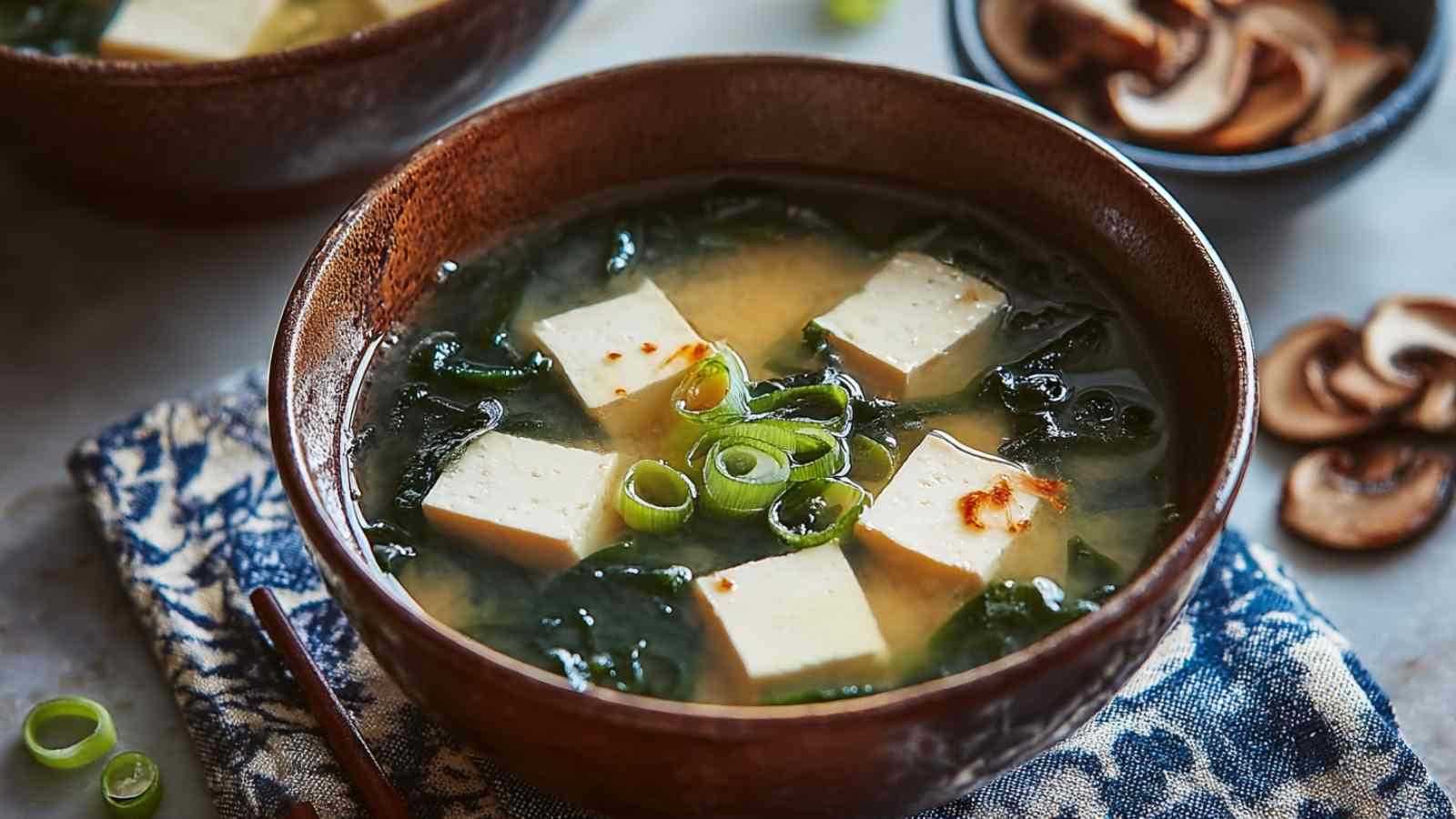Miso soup brings that perfect balance of savory umami flavors right to your kitchen, and I’ve discovered it’s one of the most satisfying soups you can make in under 10 minutes. After years of experimenting with different miso pastes and techniques, I can promise this recipe delivers authentic Japanese comfort every single time.
There’s something magical about the ritual of making miso soup that reminds me of those quiet Sunday mornings on my grandmother’s farm. While she was stirring her famous chicken and dumplings, I was fascinated by my neighbor Mrs. Tanaka, who taught me the gentle art of dissolving miso paste without creating lumps. The steam rising from that fragrant broth, the soft cubes of tofu floating like little clouds, and the delicate seaweed adding its oceanic whisper became my go-to comfort food when I needed something nourishing but didn’t have much time. Your kitchen’s about to smell incredible, and your soul is about to feel warmed from the inside out!
What Makes This Miso Soup So Special
I’ve been perfecting this miso soup recipe for over two decades, and what I love most is how it bridges my Midwest comfort food roots with authentic Japanese tradition. The beauty lies in its simplicity, just a few quality ingredients creating layers of complex, satisfying flavor.
Ready in under 10 minutes, perfect for busy weeknight dinners or quick lunch breaks
Uses pantry staples that keep well, so you can make it anytime a craving strikes
Delivers consistent, restaurant-quality results every single time
Packed with beneficial probiotics from fermented miso paste that support digestive health
Adapts easily to dietary preferences and whatever vegetables you have on hand
Creates that perfect balance of umami richness and clean, nourishing satisfaction
After serving this to countless family gatherings, I can tell you it works beautifully as either an elegant starter or a light, complete meal on its own.
Key Players in This Recipe
Miso paste forms the heart and soul of this soup, providing that distinctive umami depth that makes every spoonful satisfying. I always choose a good-quality white or red miso paste, white tends to be milder and slightly sweet, while red offers more robust, earthy flavors.
Water serves as our clean canvas, and I’ve learned that starting with filtered water really does make a difference in the final taste. The quality of your water will shine through in this simple broth.
Tofu adds gentle protein and creates those silky, cloud-like bites that make miso soup so comforting. In my kitchen, I prefer using silken or soft tofu cut into uniform cubes for the most authentic texture.
Dried wakame seaweed brings essential minerals like iodine and calcium while contributing that subtle oceanic flavor that transports you straight to Japan. I always keep dried wakame in my pantry since it rehydrates beautifully and stores for months.
Green onions provide a fresh, bright finish that cuts through the rich umami broth. I typically use both the white and green parts, chopping them finely for the best distribution of flavor.
Soy sauce acts as our optional flavor enhancer, deepening the savory notes when you want an extra layer of complexity in your miso soup.
Betty’s Tested Technique
Step 1. I’ve found that bringing your water to a full rolling boil first creates the perfect base for dissolving the miso paste completely, this prevents any grittiness in your finished soup.
Step 2. After years of making this, I learned the secret is to remove the pot from heat before adding miso paste, then whisk vigorously until completely smooth. Betty always starts by creating a small slurry with a ladle of hot water and the miso paste before adding it back to the pot.
Step 3. Through trial and error, I discovered that adding tofu cubes and wakame seaweed together allows them to heat evenly while the seaweed rehydrates to its perfect tender texture.
Step 4. The key I discovered is maintaining just a gentle simmer for exactly 5 minutes, this timing ensures the tofu warms through without becoming tough and the wakame reaches ideal tenderness.
Step 5. My family prefers when I taste and adjust the soy sauce gradually, since different miso pastes have varying salt levels and you want that perfect balance of flavors in your finished miso soup.
Step 6. I always finish with freshly chopped green onions right before serving, they add the most beautiful color contrast and fresh bite to complete this comforting bowl.
Keeping This Miso Soup Fresh
I typically store leftover miso soup in the refrigerator for up to 2 days, though honestly, it’s always best enjoyed fresh and hot from the stove. The flavors stay vibrant, but I’ve noticed the tofu can become slightly firmer after refrigeration.
For the best texture, I reheat by gently warming the soup in a saucepan over low heat, never bringing it to a full boil again, which can make the miso paste bitter and destroy those beneficial probiotics. Betty’s method works well because she adds a splash of fresh water if the soup has thickened, then stirs in a tiny bit more miso paste to brighten the flavors.
I don’t recommend freezing miso soup since the tofu texture changes dramatically and the delicate balance of flavors can become muted. This recipe is so quick to make fresh that I prefer starting from scratch each time.

Perfect Partners for Miso Soup
Steamed jasmine rice creates the perfect foundation for turning this soup into a more substantial meal, absorbing all those wonderful umami flavors while adding satisfying heartiness.
Asian Inspired Chicken Rice Bowl offers a complete meal companion that shares similar flavor profiles while providing protein and satisfying texture contrast.
Simple green salad with sesame dressing echoes the Asian flavors while adding fresh crunch and vibrant colors to your meal presentation.
Honey Garlic Chicken Stir Fry transforms this starter into a complete dinner, with the clean miso broth balancing the sweet and savory stir-fry flavors beautifully.
Garlic Butter Shrimp and Rice provides an elegant pairing that keeps the meal light yet satisfying, with both dishes sharing that perfect umami depth.
Chicken Stir Fry with Veggies makes an excellent main course that complements the soup’s clean flavors while adding protein and colorful vegetables.

Authentic Miso Soup
Ingredients
Equipment
Method
- In a pot, bring the water to a boil
- Add the miso paste and stir until dissolved
- Add the tofu cubes and wakame seaweed, then let simmer for 5 minutes
- Stir in the soy sauce if using, and top with chopped green onions before serving
Notes
FAQs
How do I know if my miso paste has gone bad?
I recommend checking for any off odors, unusual colors, or mold growth. Quality miso paste keeps for months in the refrigerator, but if it smells sour rather than pleasantly fermented, or shows any signs of spoilage, it’s time to replace it.
What type of tofu works best in miso soup?
The best approach I’ve tested uses silken or soft tofu cut into small, uniform cubes. These varieties hold together well while maintaining that characteristic tender texture that makes miso soup so comforting.
Can I add other vegetables to my miso soup?
I recommend adding vegetables like mushrooms (shiitake or enoki work beautifully), bok choy, spinach, or thinly sliced carrots during the last 2-3 minutes of cooking. The best approach I’ve tested is to add heartier vegetables first, then leafy greens at the very end to prevent overcooking.
What’s the difference between white and red miso paste?
Many home cooks find that white miso (shiro miso) is milder, slightly sweet, and perfect for beginners, while red miso (aka miso) offers more robust, earthy flavors with a deeper umami punch. I typically recommend starting with white miso and experimenting from there.
Can I make this soup ahead for meal prep?
To prevent this issue, I suggest preparing individual portions and storing the miso paste mixture separately from the other ingredients. Betty’s solution is to prepare the base ingredients and add the miso paste fresh when reheating, this preserves both the probiotics and the best flavor profile.







